Emergencies can happen at any time and often without warning. Having a clear, simple plan gives your household the best chance of staying safe, connected, and ready to respond.
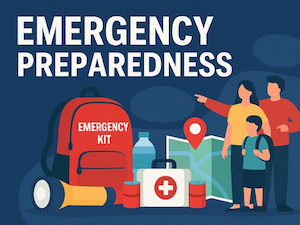
Preparedness doesn’t need to be complicated or expensive. It begins with small steps that make a big difference when emergencies strike. By taking time now to think through possible scenarios, gather essential supplies, and talk with your household about what to do, you can reduce stress, avoid confusion, and respond more effectively when every second counts.
Start With a Plan
Emergency preparedness begins with a conversation. Talk with your household about the types of emergencies that could happen where you live like tornadoes, hurricanes, thunderstorms, power outages, floods, or other severe weather events.
First, decide where to meet if you’re separated. Pick one meeting spot just outside the home and another farther away in case you can’t return to the neighborhood.
Next, make an evacuation plan and make sure everyone understands it. Identify at least two ways out of your neighborhood, and think about alternatives if roads are blocked or if you don’t have a vehicle.
In case of an evacuation, assign responsibilities ahead of time so everyone knows what to do. Figure out who will call for help, who will grab the emergency kit, who will care for pets, and who will check on neighbors.
Choose an out-of-town emergency contact and ensure everyone has that number written down and memorized. Teach children how and when to dial 911. Practice your plan at least once a year and update it when your household changes.
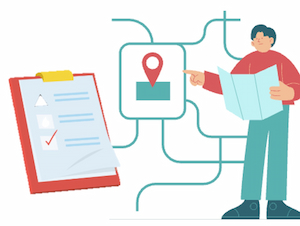
Build an Emergency Kit
Every home should have enough food, water, and emergency supplies to last at least three days. Store a portable emergency kit where it’s easy to grab if you need to evacuate, and consider keeping a smaller version in your car. Rotate supplies regularly so food and batteries don’t expire.
Your emergency kit may include:
- One gallon of water per person per day
- Non-perishable food (three-day supply)
- Personal hygiene items
- First aid kit and prescription medications
- Flashlights and extra batteries
- Battery-powered or hand-crank radio
- Cell phone charger and backup power source
- Manual can opener
- Local maps and copies of important documents
- Dust masks, plastic sheeting, and duct tape for shelter-in-place situations
Don’t forget to include personal items that meet your household’s specific needs, such as spare eyeglasses, prescription medications, pet food, baby supplies, and feminine hygiene products.
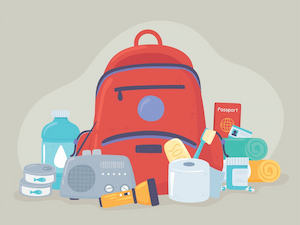
Know the Risks in Your Area
Preparedness looks different depending on where you live. Every community faces its own unique threats, and knowing what’s most likely to happen in your area is one of the most important steps you can take to stay safe.
Floods can rise quickly and create life-threatening conditions. If flooding is possible, move to higher ground right away. During flash flood warnings, never attempt to drive across flooded roads. Even shallow-looking water can hide deep currents, washed-out pavement, and debris that can sweep vehicles away. The simple rule to follow is: Turn Around, Don’t Drown.
Tornadoes can strike with little warning and cause devastating damage in seconds. If a tornado warning is issued in your area, move immediately to the lowest level of your home, such as a basement, or to a small interior room with no windows. Protect your head and neck from flying debris. Keep sturdy shoes, flashlights, and your emergency kit nearby, so you’re ready if you need to evacuate after the storm passes.
Hurricanes bring a dangerous combination of high winds, heavy rain, and storm surge. Planning ahead is critical if you live in a coastal or hurricane-prone area. Map out your evacuation route well before hurricane season begins, and avoid low-lying roads that may flood. Before the hurricane arrives, bring inside any outdoor items that could become airborne, secure your windows with shutters or plywood, and make sure your emergency supplies are stocked.
Winter storms can be just as dangerous as other severe weather. Heavy snow, ice, and extreme cold often cause power outages and make travel hazardous or impossible. Stock up on food, water, warm clothing, and blankets in advance of any potential winter storms. If you use alternative heating sources, always follow safety guidelines. Never use a generator, grill, or camp stove indoors, as they produce deadly carbon monoxide. Having a backup plan for heat and shelter is essential during prolonged outages.
Wildfires spread quickly and can devastate entire communities with little warning. If you live in a wildfire-prone area, create a defensible space around your home by clearing away dry brush, leaves, and flammable materials. Prepare an evacuation kit that includes N95 masks to protect against smoke, and make sure you know multiple routes out of your neighborhood in case one is blocked. Always follow evacuation orders immediately because delaying even a few minutes can put you at serious risk.
Earthquakes strike without warning and can cause widespread destruction in just seconds. If you live in an earthquake zone, secure heavy furniture and appliances, and store breakable items on low shelves. During an earthquake, practice “Drop, Cover, and Hold On.” If you are inside, stay there until the shaking stops. If you are outdoors, move away from buildings, trees, and power lines. Expect aftershocks and be ready to repeat protective actions as needed.
Power Outages
Extended power outages can affect nearly every part of daily life, including communication, lighting, heating, cooling, and food storage. Planning ahead ensures your household can stay safe and comfortable even when the electricity is out for days at a time.
Start by keeping your devices fully charged before storms or extreme weather arrive. Portable battery packs and backup power banks are essential to keep phones and small electronics working when outlets aren’t available.
Because ATMs and credit card systems may not work during power outages, keep cash on hand in small bills so you can purchase supplies if needed.
Lighting is another critical consideration. Place flashlights in easy-to-find locations throughout your home, such as nightstands, kitchen drawers, and entryways. Avoid using candles during a power outage, which increase the risk of fires, especially in homes with children or pets. Lantern-style battery lights can provide longer-lasting and safer illumination.
Take time now to label the circuits on your electrical panel so you know which switches control each part of your home. In some emergencies, you may need to shut off utilities to prevent damage or hazards when power is restored.
If you suspect that water service could be interrupted, fill bathtubs and containers in advance to provide extra drinking and washing water. Stock hand sanitizer, moist towelettes, and other hygiene supplies to stay clean and reduce the spread of germs.
Food safety is also a concern during outages. Keep refrigerator and freezer doors closed as much as possible to preserve cold air. A refrigerator can typically keep food safe for up to four hours without power, while a full freezer may hold temperatures for up to 48 hours. Discard anything that smells off, looks spoiled, or has been at unsafe temperatures for too long.
Finally, consider your comfort and safety if the outage lasts more than a few hours. If your home becomes too hot in the summer or too cold in the winter, identify safe alternate locations where you could stay temporarily. This might be the home of a relative or friend, a community center, or a designated public shelter. Having these options identified ahead of time reduces stress and ensures you won’t be scrambling to find shelter during an emergency.
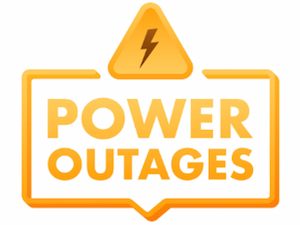
Stay Informed
It's not just about having supplies... emergency preparedness is also about knowing what’s happening around you. Emergencies can develop quickly, and having timely information helps you make safe decisions for your household.
Sign up for local emergency alert systems and weather warnings provided by your city, county, or state. These notifications can give you real-time updates about severe weather, evacuation orders, and other hazards that may affect your area. Consider also keeping a battery-powered or hand-crank radio as a backup in case cell towers go down.
Don’t rely only on your phone for critical contact information. Power outages and network failures can make it impossible to access saved numbers. Keep a printed list of important contacts in your emergency kit including family, neighbors, an out-of-town emergency contact, local utilities, and nearby hospitals.
The more ways you can receive updates, the better prepared you’ll be to respond quickly and protect your household when it matters most.
Emergency preparedness is an ongoing habit, not a one-time task. Reviewing your plan, practicing evacuation routes, and checking supplies regularly will keep you ready for whatever comes your way. A few hours of preparation now can prevent confusion, reduce risk, and help keep your family safe when disaster strikes.
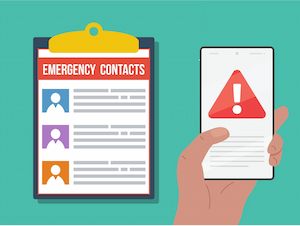
.jpg)

.jpeg)